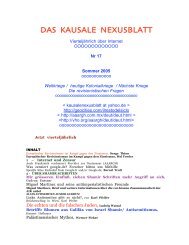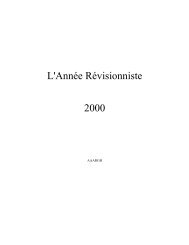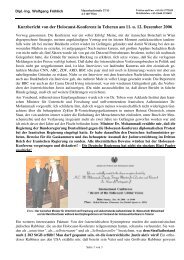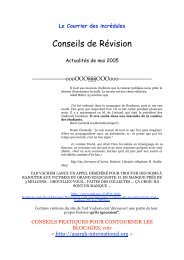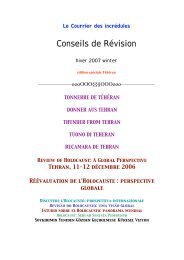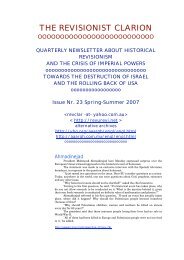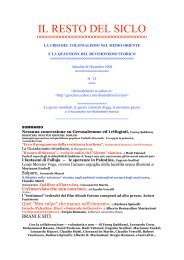Numéro 60--- ÃTà 2007 - Vho
Numéro 60--- ÃTà 2007 - Vho
Numéro 60--- ÃTà 2007 - Vho
Create successful ePaper yourself
Turn your PDF publications into a flip-book with our unique Google optimized e-Paper software.
GAZETTE DU GOLFE ET DES BANLIEUES / <strong>60</strong> / ÉTÉ <strong>2007</strong><br />
published by Ronen Bergman and Tom Segev, and reading Amit's book Head to Head,<br />
illustrates that Dimona looked to him like a possible diplomatic lever for a breakthrough with<br />
Egypt. Amit was not the only one who thought this. MK Zalman Abramov of the General<br />
Zionists and a member of the Committee to Prevent the Nuclearization of the Middle East,<br />
tried to promote similar diplomatic ideas. When I interviewed him at the beginning of the<br />
1990s, he spoke about his perception back then that it was possible and necessary to trade the<br />
Israeli nuclear option for the possibility of peace. He wrote personal memoranda dealing with<br />
this matter to Eshkol and Eban, and met with them, but it was unclear to him whether either<br />
ever did anything about it.<br />
Further evidence for Eshkol's disquiet comes from another direction. In December 1966,<br />
there was a serious industrial accident at the Dimona compound. One worker was killed, a<br />
sensitive work area was contaminated and it took many weeks to purify and seal off the<br />
damaged area. The accident shocked all those responsible for the nuclear project, including<br />
the prime minister himself. Recently published American diplomatic documents show how the<br />
U.S. ambassador to Israel at the time, Walworth Barbour, saw matters. In a letter Barbour sent<br />
in February 1967 to a senior person in the State Department's Near East Division, he wrote that<br />
he did not recall any other occasion when Eshkol had sounded so uncertain as to the future of<br />
Dimona. Barbour recommended to his correspondent that perhaps, from Washington's<br />
perspective, this was the time to move the idea of developing a large energy project, involving<br />
nuclear desalinization of water in Israel, into practice. According to Barbour, in return, Israel<br />
would place Dimona under inspection. In his letter Barbour writes that even six months earlier<br />
he had been certain that the Israelis would never be persuaded to give up their option of a<br />
nuclear weapon in return for the desalinization project, but he believed a number of new<br />
elements had entered the picture of late. He went on to say that one could sense a slackening<br />
of the determination to leave Nasser unwitting as to Israel's nuclear intentions and that the<br />
Israelis' awareness of the dangers inherent in this mode of action had become clear to him in<br />
a number of recent conversations with the prime and foreign ministers. He also wrote that his<br />
personal impression was that Dimona was not working at full-steam and that the most promising<br />
arrangement available on the horizon was the possibility that Israel would open Dimona to a<br />
significant number of non-Israeli scientists for inspection. He added that Abba Eban was<br />
thinking along those lines, which was significant, and that at least one trial balloon had been<br />
sent up recently in that direction.<br />
Another piece of indirect evidence shedding light on Eshkol's hesitations arose in an<br />
interview I conducted with Floyd Culler, who headed the American team visiting Dimona in<br />
the late 19<strong>60</strong>s. Culler also headed the team that visited Dimona in April 1967, the last visit<br />
before the war broke out. During this visit the team was officially accompanied by Professor<br />
Amos de-Shalit, the scientific director of the Weizmann Institute. On the last day of the visit,<br />
after a reception at de-Shalit's home in Rehovot, the host insisted on personally taking Culler<br />
back to his hotel in Tel Aviv. In the conversation between the two, de-Shalit brought up a<br />
number of suggestions Culler later described as the detailed thoughts of a physicist on how to<br />
prevent a nuclear Middle East. Although de-Shalit described his suggestions as "personal<br />
thoughts," Culler was convinced that the suggestions were a "trial balloon" launched on<br />
Eshkol's behalf, and he transmitted them to Washington as such.<br />
From the little Culler was prepared to say on the subject, it was obvious to me that de-<br />
Shalit had made it very clear to him that now was the time to act in order to prevent a nuclear<br />
Middle East. Unfortunately, added Culler, within weeks the crisis in the Middle East erupted,<br />
and the nuclear issue lost its relevance overnight. Even decades later, Culler still related to the<br />
conversation with great delicacy, and he refused to go into detail.<br />
Crossing the threshold<br />
We are coming to May 1967. The standard Israeli narrative until now has never<br />
discussed the war's nuclear dimension. The memoirs of Eshkol's military secretary, Colonel<br />
Yisrael Lior, which were edited by Eitan Haber in the book Today War Will Break Out (1988),<br />
for the first time revealed the aerial photographs taken by parties hostile to Israel over "strategic<br />
targets" during the waiting period, and discussed the impact these flights had on the way<br />
Israeli politicians perceived the crisis. In two reports in the early 1990s in Haaretz, Aluf Benn<br />
was, I believe, the first to say that the Six-Day War also had a nuclear dimension, citing the<br />
somewhat opaque remarks of the founder of Rafael (Armaments Development Authority),<br />
Munia Mardor, about that "fateful weapons system my people have succeeded in bringing to<br />
operational readiness."<br />
From Gluska, we learned how two high-altitude aerial photography flights over Dimona,<br />
on May 17 and 26, were critical for the IDF and the government's understanding of the<br />
— 17 —



